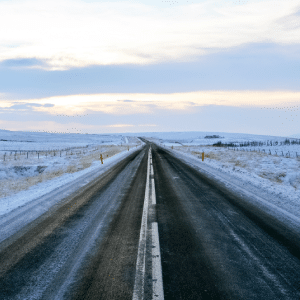
Did you know that 17 percent of all auto accidents occur in winter weather conditions? There is always a risk of getting in an accident any time you get behind the wheel of a motor vehicle, but rain, fog, wind, snow and ice can add additional risks to the driving experience.
Some tips for winter weather driving include:
Keep your speed down: This is important because rain, snow and ice can increase your stopping distance, and fog can reduce your visibility.
Plan ahead: Leave early and give yourself extra time to arrive at your destination so you don’t get stressed about being late and get tempted to drive faster. Check the weather before leaving and if it looks like you’re going to run into bad weather, look into the possibility of an alternate route that bypasses that weather. Consider postponing your drive until the weather has cleared up. If you decide to go ahead with your trip, keep a map with you.
Make sure your equipment works: Ensure you have clean headlights and working windshield wipers. Dirty headlights can reduce your visibility by a lot, especially in poor weather. Check your brakes and tires often during the winter.
Keep a safe distance behind other vehicles: California’s DMV recommends keeping three seconds of space between you and the vehicle in front of you in normal conditions. You should double this distance when ice, sleet, snow or rain is involved, as these conditions can increase your stopping distance.
Wear your seatbelt: You should always wear your seatbelt, but especially in wintery conditions, which are more dangerous than average driving conditions. Wearing your seatbelt is also mandated by law in most states.
Listen to the radio: Put a radio station on at low volume. Choose a radio station that gives information on road conditions and may tell you about road closures or alternate routes. Keep the volume down so you’re not too distracted, as bad weather conditions demand concentration while driving.
Keep an emergency kit: You should have an emergency kit in your trunk or vehicle that includes items such as:
- A bag of cat litter, salt or sand for in case you get stuck in snow
- An ice scraper
- A snow brush
- Gloves/mittens
- Emergency flares or triangles
- A first-aid kit
- A flashlight
- Batteries for the flashlight
- Shelf-stable snack foods
- Booster cables
- A cup to melt snow in for water
- Matches and a candle
Don’t hesitate to pull over: If the weather gets too bad or you’re getting tired, don’t hesitate to pull over. It’s better to arrive a bit late than to get in an accident. Make sure you’re not pulling over into snow banks or deep puddles.
How To Drive Safely In The Rain

Use your headlights: Headlights can compensate for the reduced visibility that rainy conditions lead to. Using headlights in low visibility is mandatory in every state. Using headlights while wipers are being used is required in many states.
Turn your wipers on: Make sure they’re maintained well, too. Replace them every six to 12 months.
Don’t try to navigate flooded roads: It’s very difficult to tell how deep the water is on a flooded road. Find another route.
Keep your windows clear: Your windows can fog up in rainy conditions. The defroster or air conditioner can remedy this.
Don’t use cruise control: You should control your own speed and react to changes in conditions rather than rely on cruise control in the rain.
Avoid puddles: Your car can hydroplane when driving over puddles, causing you to lose control. Driving in the tracks of the car in front of you can reduce the amount of water you drive over.
Use the middle lanes: Water tends to pool on the edges of the road rather than in the middle.
How To Drive Safely In Fog
Use your low beams: Turn your headlights on and use your low beams. High beams can actually make things worse in fog because they just reflect back into your eyes. It is important to use your low beams whether it’s day or night because they don’t just help you see, they help other cars see you.
Use turn signals early: Let cars behind you know well ahead of time when you’ll need to slow down to turn.
Keep to the right: Stay near the right hand side of the road to avoid crossing over into oncoming traffic in the fog.
Follow the white line on the right hand side of the road: Pay attention to this line. It can guide your way and keep you inside your lane.
Pull over and wait for the fog to clear: If the fog gets too thick, pull over, turn your emergency flashers on and wait for visibility to improve before continuing your journey.
How To Drive Safely In Ice Or Snow

Don’t accelerate too quickly: Trying to accelerate too quickly can cause your tires to spin in place in icy or snowy conditions. If you get stuck in snow, place sand or blocks under your drive wheels then accelerate slowly after straightening your wheels.
Watch out for bridges and overpasses: These areas of the road freeze over first.
Watch out for black ice: Black ice, a thin, transparent layer of ice on a road, can cause you to lose control of your vehicle, so watch the road ahead of you for spots that look slick.
Test your brakes: If you’ve never driven in snow, you probably don’t know that it will brake differently in the snow than on a dry road. Practice braking in an empty parking lot before making your trip.
Brake carefully: Braking too abruptly can cause you to lose control of your vehicle in icy or snowy conditions. Apply constant, firm pressure to anti-lock brakes.
Go slowly around corners: Slow down well ahead of corners. You can lose control by going around a corner too quickly in icy or snowy conditions.
How To Drive Safely In Windy Conditions
Don’t drive certain vehicles: Vehicles with high centers of gravity like trucks, SUVs, trailers and vans shouldn’t be driven in very conditions, and wind can tip them over.
Watch for debris: Keep a look out for flying debris, and be very cautious around any vehicles carrying light cargo like trailers or vans.
Don’t try to outrun a tornado: Leave your vehicle and find shelter. Lie down in a ditch or low area if you can’t get to a safe structure. Lie face down and cover the back of your neck and head with your hands to protect yourself from flying debris. Watch for flash floods.
Special Winter Weather Driving Tips For Truckers
Be aware of windy conditions ahead of time: Pay attention to the weather so you always know when you’re going to drive into windy conditions. Commercial trucks have very high centers of gravity and a lot of surface area for wind to hit, so they’re very prone to rollovers in heavy wind.
Damaged or lost cargo: Pull off the road and stop if you lose your cargo or it gets damaged in severe weather. Remove debris from the road if you can do so safely; otherwise, wait for police. Put flares by your truck to warn other drivers.

